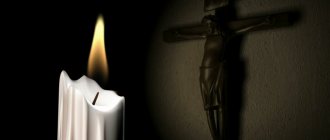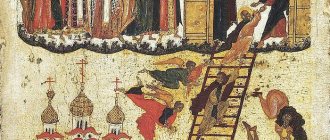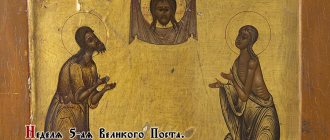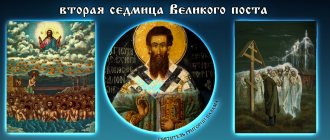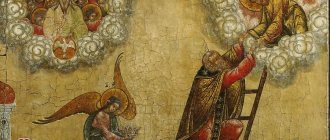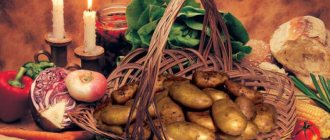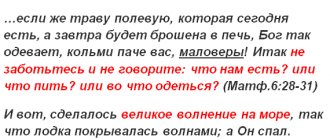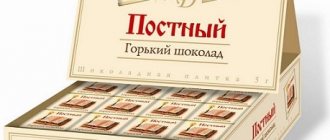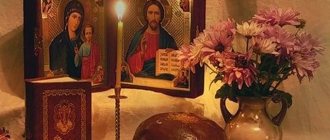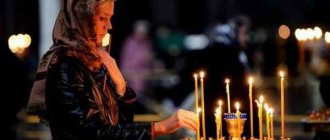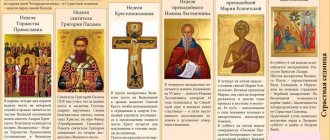The veneration week of Lent 2022 falls in its middle. Each week of Lent has a special name, reminiscent of one or another event associated with the holy great martyrs, metropolitans, miracle workers, Jesus Christ himself, the Mother of God and the Holy Trinity.
The names convey special differences in church services, in who should offer prayer and worship. This is also connected with special spiritual instructions, perceiving which Christians must unite in a single impulse, supporting each other in deed and word, let it be reflected only in prayer.
The Third Week of Great Lent is dedicated to the veneration of the Honest and Life-Giving Cross. The editors of the site vottakaya.ru found out when the week of veneration of the cross will take place and which week of Lent in 2022. What traditions exist, traditions and rituals, as well as the history of this wonderful holiday. And we will share the best recipes for Lenten Cross cookies, which are traditionally baked at home during the week of the Cross.
What is the Week of the Cross and when does it occur?
The name “cross veneration” comes from the fact that in the named week, services in the church are accompanied by bows to the sacred cross on which the Son of God was allegedly crucified (“allegedly” means that Jesus was not crucified on each of the crosses in all churches).
This action, a bow after reading a prayer, occurs four times, starting on Sunday, which is called the Worship of the Cross, and then on Monday, Wednesday and Friday.
Bowing means tribute to the feat of Christ, the desire to follow him, as well as the acceptance of one’s own burden, one’s destiny, which manifests itself every day in everyday life, such seemingly small deprivations in the form of a reduced portion of food and a complete rejection of worldly entertainment.
The meaning of the Week of the Cross lies on the surface. The people have an expression “carry your cross”; it is directly related to the explanation. During Lent, every Christian tries to bear the burden that lay on the shoulders of Jesus during the days of forty days of abstinence. Everyone experiences their own temptation based on their “weak” point.
This means that in the middle of Lent, the Christian already knew “his cross” and fully felt all the temptations that accompany abstinence, against which he raised his spirit. This is a kind of act of recognizing one’s burden as voluntary, desired.
Also, the cross is a symbol of a reminder of the death of Christ and the result of the entire fast, after which comes the sacred resurrection. Thus, on the Week of the Cross, everyone can feel inspired to continue their fast, realizing for what purpose and what result they are holding their will in their fist.
What's the point
The cross on which Jesus was crucified is a symbol of the Savior’s torment. Every believer must remember the suffering of the Lord God for the salvation of mankind. The Savior sacrificed his earthly life to atone for the sins of people.
Of particular importance is the celebration in honor of the Cross in the middle of Lent (on the eve of Holy Easter). Worship of the crucifix helps strengthen faith in the Lord, overcome devilish temptations and demonic obsessions.
Traditionally, Orthodox believers observe strict fasting before Easter. Christians refuse hearty food and entertainment, remembering that these days, many centuries ago, Jesus suffered for the salvation of mankind. It is the feast of the exaltation that helps everyone who fasts and honors the memory of the torment of the Lord to pass this test with honor. Solemn worship of the crucifix inspires believers, gives them strength and patience.
The cross erected in the church is not only a reminder of the suffering of the Lord, but also a banner of victory over the devil. On this day all troubles and sorrows are forgotten. Christians feel a surge of strength and uplifting spirit. The Lord's crucifixion works miracles: it heals the sick, casts out demons, and protects from evil forces.
Story
During the Iranian-Byzantine War in 614, the Persian king Khosroes II besieged and took Jerusalem, taking the Jerusalem Patriarch Zechariah captive and capturing the Tree of the Life-Giving Cross, once found by Equal-to-the-Apostles Helen.
In 626, Khosroes, in alliance with the Avars and Slavs (yes, Slavs!) almost captured Constantinople. Through the miraculous intercession of the Mother of God, the capital city was delivered from the invasion, and then the course of the war changed, and in the end the Byzantine Emperor Heraclius I celebrated the victorious end of the 26-year war.
Presumably on March 6, 631, the Life-Giving Cross returned to Jerusalem. The emperor personally carried him into the city, and Patriarch Zacharias, rescued from captivity, walked joyfully next to him. Since then, Jerusalem began to celebrate the anniversary of the return of the Life-Giving Cross.
It must be said that at that time the duration and severity of Lent were still being discussed, and the order of Lenten services was just being formed. When the custom arose of moving the holidays that occur during Lent from weekdays to Saturdays and Sundays (so as not to violate the strict mood of weekdays), then the holiday in honor of the Cross also shifted and gradually became assigned to the third Sunday of Lent.
Just from the middle of Lent, intensive preparation began for those catechumens who were going to be baptized on Easter this year. And it turned out to be very appropriate to begin such preparation with the veneration of the Cross.
Starting next Wednesday, at each Presanctified Liturgy, after the litany for the catechumens, there will be another litany for those “preparing for enlightenment” - precisely in memory of those who diligently prepared and were planning to be baptized soon.
Over time, the purely Jerusalem holiday of the return of the Cross became not so relevant for the entire Christian world, and the holiday in honor of the Cross acquired a more global meaning and a more applied meaning: as a remembrance and help in the middle of the strictest and most difficult of fasts.
Why is the Cross important?
Jesus Christ was crucified on the cross. At the same time, it is considered a kind of heavenly tree, where every traveler can relax in the shade and gain strength. The cross in the middle of the path, which every fasting believer passes, inspires to further the righteous path and gives strength for further abstinence. Worship of the cross continues throughout the week. Only on Friday is he returned to the altar.
According to the clergy, the cross is the main instrument of our salvation, a symbol not only of the atoning death of Christ, but also of His resurrection, which opened the way to heaven for all who are ready to follow Christ.
Also, the image of the cross also says that our whole life is carrying our own cross and that Holy Week is ahead, to which fasting leads.
When and how does the Orthodox week of veneration of the cross take place?
Many of these sources call the 4th week of Lent the Worship of the Cross, which seems quite logical and memorable, given the clue that it falls exactly in the middle of Lent. However, in fact the name
The veneration of the cross begins the week with the Sunday of the same name, which ends the 3rd week of Lent. Consequently, the week of the Veneration of the Cross is the third, despite the fact that a greater number of services with veneration of the cross take place in the 4th week.
On the mentioned Sunday, the first service with bows to the cross takes place. The next one takes place on Monday, exactly one day later. Also on Wednesday and Friday evening of the 4th week, the last service of the Cross takes place, after which the cross takes its place in the altar.
The veneration week of Lent in 2022 falls on March 20. On this day, the traditional removal of the cross to the middle of the temple hall will take place, so that every worshiper can bow to the ground before it and be inspired by the feat done by Jesus to continue the fast.
During the liturgy these days, the prayer to the Most Holy Trinity, which traditionally accompanies the service every day, is replaced by the prayer hymn “We worship Your Cross, O Master, and holyly we glorify Your Resurrection,” after which bows should be made.
If possible, you should visit all 4 services. The single voice of dozens, turned into prayer, can create a miracle, especially if our will has weakened under the pressure of routine.
Church service
On Saturday evening, at the all-night vigil, the Life-giving Cross of the Lord is solemnly brought into the center of the church - a reminder of the approaching Holy Week and Easter of Christ. After this, the priests and parishioners of the temple make three bows in front of the cross. When venerating the Cross, the Church sings: “We worship Your Cross, O Master, and we glorify Your holy resurrection.” This chant is also sung at the Liturgy instead of the Trisagion.
The Holy Cross remains for veneration during the week until Friday, when it is brought back to the altar before the Liturgy. Therefore, the third Sunday and fourth week of Great Lent are called “Worship of the Cross.”
According to the Charter, there are four venerations during the Week of the Cross: Sunday, Monday, Wednesday and Friday. On Sunday, the veneration of the Cross occurs only at Matins (after the removal of the Cross), on Monday and Wednesday it is performed at the first hour, and on Friday “after the dismissal of the hours.”
Liturgical texts in honor of the Cross are very sublime and beautiful; they are replete with contrasts, allegories, and artistic personification.
On what dates?
Christians of all denominations worship the Cross, erect it in a temple and arrange a holiday in honor of it, although on different days. In Orthodoxy, it is customary to glorify the symbol of the torment of Christ on the third Sunday of the most holy Great Lent. The bright holiday on the eve of Easter is called the Week of the Cross.
In addition to this celebration, on September 14 (27), Orthodox believers celebrate the Exaltation of the Holy Life-Giving Cross.
After all, it was on this day that many centuries ago (in 335) the first celebration took place in honor of the relic found in Calvary. Catholics erect the Holy Cross in their churches on September 14. On the holiday, a festive church service is held, believers pray and glorify this symbol of Christianity.
Lent 2022: meals in the third week (March 20 - 26)
- March 20 – Sunday
Second week of Lent (second Sunday of fasting). Memorial Day of St. Gregory Palamas. St. Gregory Palamas lived in the 14th century. In accordance with the Orthodox faith, he taught that for the feat of fasting and prayer, the Lord illuminates believers with His gracious light, as the Lord shone on Tabor. For the reason that St. Gregory revealed the teaching about the power of fasting and prayer and it was established to commemorate him on the second Sunday of Great Lent.
- March 21 – Monday
Dry eating: bread, water, greens, raw, dried or soaked vegetables and fruits (for example: raisins, olives, nuts, figs - one of these every time). Once a day, around 15.00.
- March 22 – Tuesday
Hot food that has been cooked, i.e. boiled, baked, etc. No oil. Once a day, around 15.00.
- March 23 – Wednesday
Dry eating: bread, water, greens, raw, dried or soaked vegetables and fruits (for example: raisins, olives, nuts, figs - one of these every time). Once a day, around 15.00.
- March 24 – Thursday
Hot food that has been cooked, i.e. boiled, baked, etc. No oil. Once a day, around 15.00.
- March 25 – Friday
Dry eating: bread, water, greens, raw, dried or soaked vegetables and fruits (for example: raisins, olives, nuts, figs - one of these every time). Once a day, around 15.00.
- March 26 – Saturday
Hot food that has been cooked, i.e. boiled, baked, etc. With vegetable oil and wine (one bowl 200g) twice a day. Pure grape wine without alcohol and sugar, preferably diluted with hot water. At the same time, abstaining from wine is highly commendable.
On Saturday of the third week, during Matins, the Life-Giving Cross of the Lord is brought into the middle of the church for the worshipers to worship, therefore the third week and the next, fourth, week are called the Worship of the Cross.
Why this holiday?
The essence of the Week of the Cross is simple. Each believer has reached the middle of fasting - he is tired and even begins to doubt the correctness of his actions during abstinence. Near the Cross, he will regain faith and strength, see with his own eyes the feat of Jesus, and this gives inspiration for the further difficult path to Easter.
The main thing you need to realize during the week of the cross is the strength of your spirit and patience. Having endured three weeks, each of the believers is ready to break down, especially since there are plenty of temptations in the world - the Cross can return you to the right direction and help you cope with temptation.
Also, in its service on the fourth week of Lent, the church honors the memory of St. John Climacus. His life became an example of a highly spiritual fasting life, and the essay “Ladder” (ladder) he wrote became a real guide to ascent to spiritual perfection.
Cookies in the shape of crosses for the week of the Cross
There was such an interesting Russian folk tradition - baking cookies in the form of crosses on the Cross. Crosses may differ in size, but they are always of a similar shape; most often they are made symmetrical, equilateral, with four rays.
To do this, two equal strips of dough are placed on top of one another in a cross shape (these are “simple” crosses). or the rolled out dough is cut into “crosses” with a mold or knife (these are “cut-out” crosses).
Sometimes they are made even simpler - in the form of round cakes, on which the image of a cross is applied. According to legend, such Crosses “drived away” everything bad from the house and household members.
Ivan Shmelev in his book “The Summer of the Lord” described this custom well. I will give an extensive quote here - Shmelev very vividly showed how such a tradition is inscribed in the order of life and thinking of an Orthodox, church child. Shown the “presentation angle” of this custom:
“On Saturday of the third week of Lent we bake “crosses”: “Cross Worship” is suitable. “Crosses” – special cookies, with almond flavor, crumbly and sweet; where the crossbars of the “cross” lie – raspberries from jam are pressed in, as if nailed down with nails. They have been baking this way since time immemorial, even before great-grandmother Ustinya - as a consolation for Lent. Gorkin instructed me like this: “Our Orthodox faith, Russian... it, my dear, is the best, the most cheerful!” It eases the weak, enlightens despondency, and brings joy to the little ones.
And this is the absolute truth. Even though it’s Lent for you, it’s still a relief for the soul, “crosses.” Only under great-grandmother Ustinya there are raisins in sadness, and now there are cheerful raspberries.
“Worship of the Cross” is a sacred week, a strict fast, something special, “su-lip,” Gorkin says so, in the church way. If we kept it strictly in the church way, we would have to remain in dry eating, but due to weakness, relief is given: on Wednesday-Friday we will eat without butter - pea soup and vinaigrette, and on other days, which are “variegated”, - indulgence... but on The snack is always “crosses”: remember the “Worship of the Cross”. Maryushka makes “crosses” with prayer...
And Gorkin also instructed: “Taste the cross and think to yourself, ‘The venerable cross’ has come.” And these are not for pleasure, but everyone, they say, is given a cross in order to live an exemplary life... and to bear it obediently, as the Lord sends a test. Our faith is good, it does not teach evil, but brings understanding.”
Recipe for almond cookies "Cross"
Products:
- 150 g peeled almonds,
- 1⁄2 cup boiling water,
- 100 g honey,
- 1 lemon slice with skin about 1 cm thick,
- 1⁄2 tsp each cinnamon and nutmeg,
- 1⁄4 cup olive oil,
- 250 g wheat flour,
- 50 g rye flour,
- 2/3 sachet of baking powder.
How to cook:
Wash the almonds and pour boiling water for 10 minutes. Add honey, butter, a slice of lemon and grind with a blender. Mix flour, baking powder and spices.
Pour the nut-honey syrup into the flour and knead the dough, which should eventually be rolled into a ball. Leave the dough in the refrigerator for half an hour, then roll it out into a thin layer (about 5 mm) and cut out crosses. Bake at 190 degrees for 20-25 minutes.
Honey cross cookies
Ingredients:
- 2 cups of flour,
- 300 g honey,
- 2-3 tbsp. spoon of vegetable oil,
- 100 g peeled nuts,
- 1 teaspoon of spices,
- 1 lemon,
- 1 teaspoon soda, raisins.
Preparation
Grind the kernels of nuts (walnuts, almonds or hazel) thoroughly or mince them, combine with honey, add vegetable oil, spices and finely grated lemon with zest.
Mix the mixture, add flour mixed with soda and knead the dough.
Roll it out, cut crosses with a notch or a knife, put the raisins on top and bake in the oven. To flavor cookies, you can use various spices: cinnamon, cloves, cardamom, ginger, nutmeg, etc., as well as their mixtures.
Lemon crosses
Required:
- 250 g lean margarine,
- 3 cups flour,
- 1 cup potato starch,
- 1 tbsp. l. baking powder,
- 2 packets of vanilla sugar,
- zest of 1 lemon,
- 1 glass of water.
We bake Lenten lemon cross cookies:
Chop margarine with flour and starch. Add sugar, baking powder, finely grated zest and replace the dough with very cold water (from the refrigerator). Make crosses by pressing raisins into the crossbars and bake.
Cookies Crosses with cucumber pickle
Products:
- 1 glass of cucumber pickle,
- 1 cup refined sunflower oil,
- 1 cup of sugar,
- 100 g coconut flakes,
- 2-3 cups of flour.
A simple recipe for Lenten crosses in brine cookies:
Mix butter, sugar, brine, half the chips and flour. Knead the dough as thick as shortbread. Roll out, sprinkle with remaining coconut shavings.
Cut out the crosses, place on a baking sheet lightly sprinkled with flour and bake at 180 degrees for 5-8 minutes.
Instead of coconut flakes, you can use poppy seeds, lemon zest, candied fruits, dried apricots, cut into small pieces or dried orange peels crushed in a coffee grinder.
About the Worship of the Cross
The word about the cross is foolishness to those who are perishing, but to us who are being saved it is the power of God” (1 Cor. 1:18). For “the spiritual man judges all things, but the natural man does not receive the things of the Spirit of God” (1 Cor. 2:15,14). For this is madness for those who do not accept with faith and do not think about the Goodness and Omnipotence of God, but investigate divine affairs through human and natural reasoning, for everything that belongs to God is above nature and reason and thought.
And if someone begins to weigh how God brought everything from non-existence into existence and for what purpose, and if he wanted to comprehend this through natural reasoning, then he will not comprehend. For this knowledge is spiritual and demonic. If someone, guided by faith, takes into account that the Divine is good and omnipotent, and true, and wise, and righteous, then he will find everything smooth and even and the path straight.
For without faith it is impossible to be saved, because everything, both human and spiritual, is based on faith. For without faith, neither the farmer cuts the furrows of the earth, nor the merchant on a small tree entrusts his soul to the raging abyss of the sea; neither marriages nor anything else in life happens. By faith we understand that everything is brought from non-existence into existence by the power of God; By faith we do all things correctly - both divine and human. Faith, further, is uncurious approval.
Every act and miracle-working of Christ, of course, is very great and divine and amazing, but most amazing of all is His Honorable Cross. For death has been overthrown, ancestral sin has been destroyed, hell has been robbed, the Resurrection has been given, we have been given the power to despise the present and even death itself, the original bliss has been returned, the gates of heaven have been opened, our nature has sat at the right hand of God, we have become children of God and heirs not through anything else, but through the Cross of our Lord Jesus Christ.
For all this was arranged through the Cross: “all of us who were baptized into Christ Jesus,” says the apostle, “were baptized into His death” (Rom. 6:3). “As many of you as were baptized into Christ have put on Christ” (Gal. 3:27). And further: Christ is God’s power and God’s wisdom (1 Cor. 1:24). It is the death of Christ, or the Cross, that clothed us in the hypostatic Wisdom and Power of God. The power of God is the word of the cross, either because through it the power of God was revealed to us, that is, victory over death, or because, just as the four ends of the Cross, uniting in the center, firmly hold on and are tightly connected, so through the power God contains both height, and depth, and length, and breadth, that is, all visible and invisible creation.
The cross was given to us as a sign on our foreheads, just as circumcision was given to Israel. For through him we, the faithful, are distinguished from the unbelievers and are known. He is a shield and a weapon, and a monument to victory over the devil. He is a seal so that the Destroyer will not touch us, as Scripture says (Ex. 12:12,29). He is the rebellion of those who lie down, the support of those who stand, the staff of the weak, the rod of the shepherd, the returning guide, the prosperous path to perfection, the salvation of souls and bodies, the deviation from all evils, the author of all good things, the destruction of sin, the sprout of resurrection, the tree of Eternal Life.
So, the tree itself, precious in truth and venerable, on which Christ offered Himself as a sacrifice for us, as consecrated by the touch of both the Holy Body and the Holy Blood, should naturally be worshiped; in the same way - and nails, a spear, clothes and His holy dwellings - a manger, a den, Golgotha, the saving life-giving tomb, Zion - the head of the Churches, and the like, as the Godfather David says: “Let us go to His dwelling, let us worship at the footstool of His feet.” And what he means by the Cross is shown by what is said: “Become, O Lord, to the place of Your rest” (Ps. 132:7-8). For the Cross is followed by the Resurrection. For if the house, and the bed, and the clothing of those whom we love are desirable, how much more is that which belongs to God and the Savior, through which we are saved!
We also worship the image of the Honest and Life-Giving Cross, even if it were made of a different substance; We worship, honoring not the substance (let it not be!), but the image, as a symbol of Christ. For He, making a testament to His disciples, said: “Then the sign of the Son of Man will appear in heaven” (Matthew 24:30), meaning the Cross. Therefore, the Angel of the Resurrection said to the wives: “You are looking for Jesus of Nazareth, crucified” (Mark 16:6). And the apostle: “we preach Christ crucified” (1 Cor. 1:23). Although there are many Christs and Jesuses, there is only one – the Crucified One. He did not say, “pierced with a spear,” but, “crucified.” Therefore the sign of Christ must be worshiped. For where the sign is, there He Himself will be. The substance from which the image of the Cross consists, even if it were gold or precious stones, should not be worshiped after the destruction of the image, if this happened. So, we worship everything that is dedicated to God, paying respect to Him Himself.
The Tree of Life, planted by God in Paradise, prefigured this Honest Cross. For since death entered through the tree, it was necessary that Life and Resurrection should be given through the tree. The first Jacob, bowing to the end of Joseph's rod, denoted the Cross by means of an image, and, blessing his sons with alternating hands (Gen. 48:14), he very clearly inscribed the sign of the Cross.
The same thing was meant by the rod of Moses, which struck the sea in a cross shape and saved Israel, and drowned Pharaoh; hands stretched out crosswise and putting Amalek to flight; bitter water that is sweetened by the tree, and a rock that is torn and pours forth springs; the rod that gives Aaron the dignity of the clergy; the serpent on the tree, lifted up as a trophy, as if it had been put to death, when the tree healed those who looked with faith on the dead enemy, just as Christ, in the flesh that knew no sin, was nailed for sin.
The great Moses says: you will see that your life will hang on a tree before you (Deut. 28:66). Isaiah: “I stretched out My hands all day long to a disobedient people, who walked in an evil way, according to their own thoughts” (Isaiah 65:2). Oh, that we who worship him (that is, the Cross) would receive our inheritance in Christ, Who was crucified!
Venerable John of Damascus
